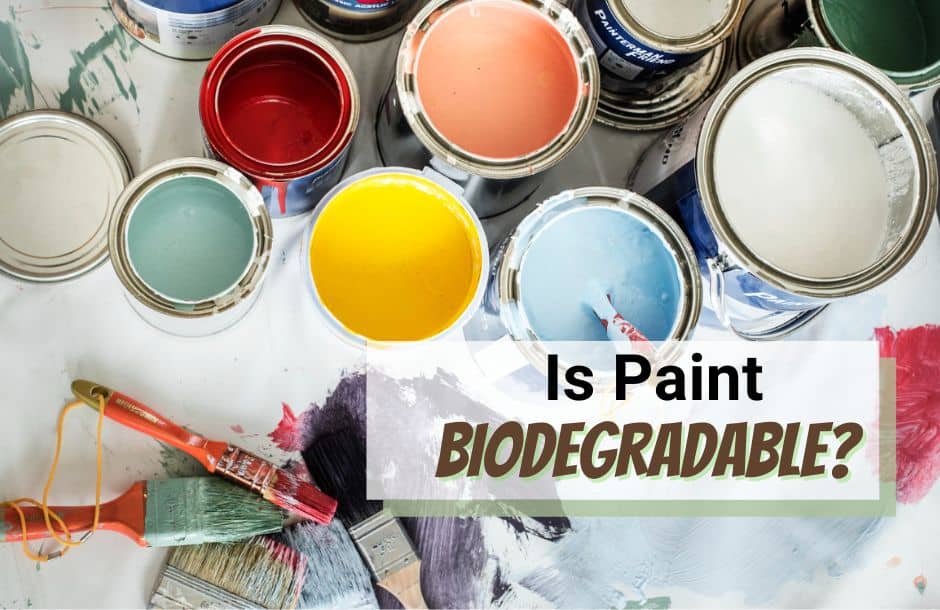Is paint biodegradable?
Is paint biodegradable? The answer to this question is not so straightforward. A variety of factors must be considered, including the type of paint, the conditions under which it biodegrades, and the length of time required for biodegradation.
Most conventional paints are made from a variety of synthetic chemicals, including acrylics, polyurethanes, and vinyls. As a result, they are not biodegradable. In fact, many of these chemicals are toxic and can pose a threat to the environment.
However, there are some paints that are biodegradable. These paints are made from natural ingredients, such as vegetable oils, lime, and milk. They biodegrade more quickly than conventional paints, and they are less harmful to the environment.
Biodegradable paints can be used for both indoor and outdoor applications. They are available in a variety of colors and textures, and they can be used to paint walls, ceilings, floors, and other surfaces.
Biodegradable paint benefits
Paint is traditionally composed of four main ingredients: pigments, binders, solvents, and additives. Of these, the solvents are the most environmentally unfriendly, as they can release toxins into the air and water. Traditionally, solvents have been petroleum-based, but with the increasing awareness of the damage these products can cause, more and more paint manufacturers are turning to solvents made from plant-based materials.
Eco vs Regular Paint
There are two types of paint: eco paint and regular paint. Eco paint is made from plant-based materials, while regular paint contains solvents that are harmful to the environment.
Eco paints are non-toxic, VOC-free, and often made from sustainable materials. They are also less likely to cause allergic reactions, and are safer to use around children and pets.
Regular paint is a type of paint that is typically used to paint walls, ceilings, and other surfaces in a home. It is available in a variety of colors and can be purchased at most home improvement stores.
Regular paint is made up of a pigment, a binder, and a solvent. The pigment is what gives the paint its color, the binder is what helps the paint stick to the surface, and the solvent is what helps the paint to spread out and dry.
There are two main types of regular paint: latex and oil-based. Latex paint is made from acrylics and is water-based. It is typically used in homes because it is easier to clean up than oil-based paint and it doesn’t have a strong odor. Oil-based paint is made from linseed oil and is solvent-based. It is typically used in commercial settings because it is more durable than latex paint.
There are also two main types of regular paint finishes: matte and glossy. Matte paint has a dull finish and is used to hide imperfections in the surface. Glossy paint has a shiny finish and is used to highlight the details in a surface.
Regular paint can be used on a variety of surfaces, including wood, metal, concrete, and masonry. It is important to always test a small area of the surface to make sure the paint will adhere properly. In addition, it is important to use the correct type of paint for the surface you are painting. For example, oil-based paint should never be used on a surface that is made from a synthetic material, like plastic.
Regular paint is a versatile and affordable paint that can be used to paint most surfaces in a home. It is available in a variety of colors, finishes, and types.
Types of Biodegradable Paints
There are a variety of biodegradable paints on the market, including milk paint, green paints, and natural paints. Milk paint is made from milk proteins, green paints are made from sustainable materials like plant extracts and mineral pigments, and natural paints are made from natural oils and resins.
- Milk Paint
Milk paint is a type of eco paint made from milk proteins. It is non-toxic, VOC-free, and biodegradable. Milk paint is also breathable, which means it allows walls to “breath” and helps prevent the formation of mold and mildew.
- Green Paints
Green paints are made from sustainable materials like plant extracts and mineral pigments. They are non-toxic, VOC-free, and biodegradable. Green paints are also often low in odor, making them safer to use around children and pets.
- Natural Paints
Natural paints are made from natural oils and resins. They are non-toxic, VOC-free, and biodegradable. Natural paints are also often low in odor, and can be used to create a variety of finishes, from sheen to matte.
What Paints are bad for the environment?
While eco paints are becoming more popular, many traditional paints still contain harmful solvents that are bad for the environment. Some of the worst offenders include acrylic paints and latex paints.
- Acrylic Paint
Acrylic paint is made up of pigment, water, and a synthetic polymer. It is often used by artists because it is versatile and dries quickly. However, acrylic paint is bad for the environment because it contains toxic chemicals that can harm both people and wildlife.
The synthetic polymer in acrylic paint is made from petrochemicals, which are derived from fossil fuels. These fuels produce greenhouse gases that contribute to climate change, and when they are burned, they release harmful pollutants into the air.
The pigments in acrylic paint can also be harmful to people and animals. Some of them are toxic and can cause respiratory problems, skin irritations, and other health issues.
Additionally, acrylic paint is bad for the environment because it is not biodegradable. When it is dumped into waterways, it can contaminate the water supply and harm fish and other aquatic creatures.
So, if you’re an artist, it’s best to avoid using acrylic paint and switch to a more environmentally friendly alternative. There are many water-based paints available that are just as versatile as acrylic paint but are better for the planet.
- Latex Paint
Latex paint is made from water, pigment, and a bonding agent called latex. It is the most popular paint in the United States, making up about 75% of the market. It has many benefits, such as being easy to use, durable, and affordable. However, there are also some significant environmental drawbacks to latex paint.
The main problem with latex paint is the emissions from the manufacturing process. The latex is made from petrochemicals, which come from oil and natural gas. These emissions contain volatile organic compounds (VOCs), which are harmful to both people and the environment. They can cause respiratory problems, damage buildings and other structures, and contribute to climate change.
In addition, the paint itself is harmful to the environment. Once it is applied, it can seep into the soil and groundwater, where it can contaminate water supplies. It can also damage trees and other plants.
Overall, latex paint is not good for the environment. The emissions from the manufacturing process are harmful to people and the environment, and the paint itself can contaminate water supplies and damage plants. If you can, try to use a non-toxic, environmentally friendly paint instead.
FREQUENTLY ASKED QUESTIONS
Is acrylic paint biodegradable?
No, acrylic paints are not biodegradable.
Is latex paint biodegradable?
No, latex paints are not biodegradable.
key takeaways
The benefits of using eco-friendly paints are clear. Not only do they help protect the environment, but they also have health benefits for people and animals. By choosing eco-friendly paints, we can all play a part in creating a more sustainable future.

